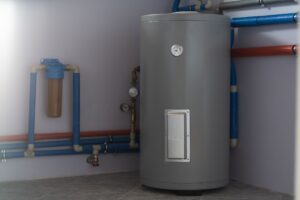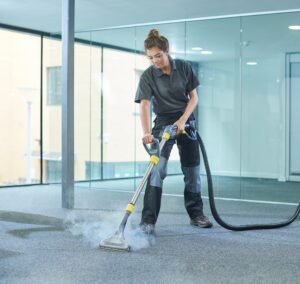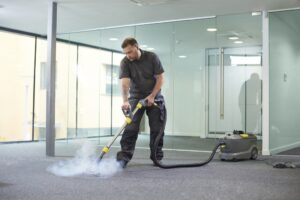Water Heater Repair Denver is the most common model powered by electricity or natural gas. When hot water is needed, it enters the tank and rises to the thermostat.
When the thermostat senses a temperature change, the heating mechanism turns on. Then, the water flows from the heat-out pipe to the faucet or appliance.

A tank water heater is a cost-effective option for many homes. It stores water and keeps it hot until needed, so managing a hot-water supply like you might have with an on-demand or gas unit is unnecessary.
A new tank water heater costs about $2,500 to $3,500, including installation costs. The size of the heater and the fuel type are important factors that will impact its final cost.
If you choose a gas model, expect to pay more than an electric model. The installation cost is also impacted by whether you need to install a new natural gas line or special venting.
It’s important to hire a professional to perform the installation. They can assess your home and recommend the best tank water heater. They will also help you decide between a tank or tankless unit. They’ll consider your current water usage and how it might change. They’ll also help you decide on the right capacity for your home based on peak demand. This is the water your household needs at the highest point in an hour, such as when everyone takes a shower or runs the laundry washing machine.
There are four basic types of residential water heaters: tank-type, hybrid, tankless, and point-of-use units. While tank storage units are still the most popular, hybrid and tankless models are growing and offering improved energy efficiency. Point-of-use units deliver hot water to appliances and fixtures far from the main water heater.
Before installing a new water heater, you’ll need to know how much it will cost to replace or repair your existing one. You must consider your family’s size, hot-water usage, and budget. You’ll also want to know how long the new unit will last and if you have hard water in your home. A plumber will be able to give you a better idea of the total cost of your project, including any necessary repairs and replacement parts.
Installing a new tank water heater takes time and effort. It’s important to follow the manufacturer’s instructions and local installation codes and have all the necessary tools. Before beginning, turn off the power and gas supply to the old water heater. It is also a good idea to connect a garden hose to the drain valve and run it outside to allow all the water to drain. Then, remove the water heater access plates and disconnect the water lines. You can use a tubing cutter to cut the gas line. Once the line is disconnected, open the drain and hot water valve at the water heater. Be careful – the water may be very hot!
Once the water is heated, it travels from the tank’s openings to your home’s hot water supply pipes. The water heater usually includes the temperature and pressure relief valve, a heat trap, and a discharge pipe. They can be purchased at your local hardware store if they aren’t. Be sure to wrap the threads of the temperature and pressure relief valve with Teflon tape before screwing it into the tank. You should also add a copper discharge pipe. This pipe should be insulated to protect it from freezing temperatures.
Before connecting the water supply lines, ensure that the voltage, wiring size, and circuit breaker are appropriate for the water heater. In addition, you should replace any exposed copper wire and add a UL-listed or CSA-approved water heater thermocouple.
It is recommended that you use copper pipe fittings with a Teflon seal. If the hoses aren’t sealed properly, they could leak and cause an electrical fire. It is also important to use short plastic-lined nipples to shield them from corrosion from hard water. You should also put a layer of plumber’s tape or pipe joint compound on the ends of each nipple to ensure a secure connection. Once the nipples are in place, you can connect them to the gas line. After re-connecting the gas line, you should test for leaks by turning on a faucet and running soapy water over the connections.
A standard tank storage water heater uses natural gas or electricity to warm the water. It works by heating cold water in pipes and storing it at the expected temperature inside a cylindrical metal storage tank until needed. During this cycle, the hot water system remains active while household members shower, wash laundry, and use other appliances and fixtures. When the demand for hot water exceeds the supply stored in the tank, a gas burner turns on, and the process begins again.
The energy efficiency of a traditional tank storage water heater depends on the type of fuel used, the size of the unit, and the piping that delivers it to end-users. In general, gas-powered units have lower operating costs than electric models. Regardless of fuel source, an ENERGY STAR-certified model offers higher efficiency than conventional tanks.
Electric water heaters with tank-mounted electric resistance elements are among the most efficient models. These systems also tend to be quieter than most other water heaters and use less water than their gas counterparts.
However, electric water heaters can be subject to problems. They can experience short-circuiting or element failure, requiring replacement or repairs. If this happens, a professional should be consulted to ensure your water heater’s safe and efficient operation.
The amount of hot water you use daily determines your water heater’s size. To resolve this, add up the gallons per minute flow rates for all fixtures and appliances in your home. This will give you your peak hour demand, which you can compare to a specific water heater’s first-hour rating (FHR).
If you choose a gas-powered tank water heater, look for a condensing model with an efficiency factor of 0.84 or greater. These models capture waste heat from flue gases and transfer it to incoming cold water for heating, which allows them to achieve significantly higher efficiency ratings than non-condensing gas water heaters.
Depending on the size of your home, you can save even more by choosing a combination appliance that incorporates a tankless water heater for space and water heating. These units are a good choice for homes using natural gas as a primary heating source since they can use the existing gas piping.
The average hot water tank needs to be drained and flushed one time per year to remove the buildup of sediment that can reduce its efficiency and shorten its lifespan. A professional technician can do this for an average of $140. This service may include relighting the pilot light, which can cost an additional $15 or so on average. Occasionally, the anode rod may also need to be replaced, costing an average of $20.
If you’re experiencing discoloration or odors in your water, it’s important to identify the source of the problem. These issues often cause a reaction between the anode rod and sulfur in your water supply. The best way to solve this issue is by replacing the anode rod, but if this doesn’t work, you may need to drain and flush your water heater.
Another common maintenance issue is a tripped breaker or fuse. This is typically an easy fix and will only cost about $20 if you hire someone to reset or replace the breaker or fuse.
In addition to tripped and blown fuses, your gas water heater can have problems with the thermocouple or gas control valve. These are more complicated repairs requiring a professional technician to diagnose and repair the issue.
Gas water heaters can also experience other issues, such as a dip tube that becomes worn out or leaks. The dip tube is a pipe that transfers cool water back to the bottom of the tank to be reheated by the lower element. If the dip tube is leaking, it can mix cool water with hot water and reduce the overall temperature of your water.
Thermocouples and gas control valves can wear out over time and must be repaired or replaced when they go bad. Having one of these parts fail can be very dangerous, so it’s best to let a professional handle the repairs for you. The average cost to have a professional replace the thermocouple or gas control valve is $150 or so, with the thermocouple costing about $20 on average.

